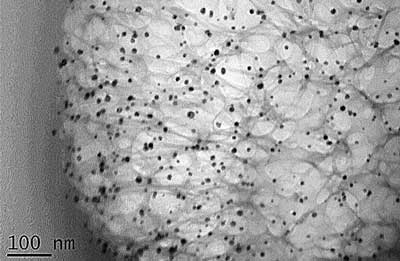| Posted: Jul 04, 2017 |
Killing bacteria with a silver-cotton nanocomposite material
(Nanowerk News) Silver has been used as an antimicrobial agent for more than 100 years. Today, silver in the form of nanoparticles is incorporated in such products as plastic food containers, medical materials, and clothing. In textiles, however, preventing the nanoparticles’ antimicrobial properties from washing away has always been a problem. But not anymore.
|
|
Scientists at the Agricultural Research Service’s (ARS) Southern Regional Research Center (SRRC) in New Orleans, Louisiana, have developed a method to trap silver nanoparticles inside cotton fibers, where they remain wash after wash.
|
 |
| Cross-section of a cotton fiber with silver nanoparticles (black dots) trapped inside it. (Image: Sunghyun Nam)
|
|
The amount of silver nanoparticles required to kill bacteria is extremely small, which makes them efficient and cost effective to use. Moreover, the new method, developed by ARS materials engineer Sunghyun Nam and her colleagues, is inexpensive and eco-friendly.
|
|
Typically, silver nanoparticles—particles that are 1 to 100 nanometers in diameter—are grown in a bulk chemical solution. In the new technology, the silver nanoparticles are produced within the cotton fibers, making their application more effective and affordable.
|
|
Silver nanoparticles slowly release silver ions that can kill more than 600 kinds of bacteria, including E. coli, says Nam, who works in the SRRC Cotton Chemistry and Utilization Research Unit. The problem has been that currently available methods could only apply silver nanoparticles to the surface of fibers, where they would wash away.
|
|
“Our new process grows and traps the silver nanoparticles inside cotton fibers,” Nam says. “They release their silver ions very slowly, killing bacteria for a long time. Our process also allows us to produce extremely small nanoparticles, about 12 nanometers in diameter.” One nanometer is a billionth of a meter. For example, a sheet of paper is about 100,000 nanometers thick. The extremely small size of the silver nanoparticles results in a larger surface area, which increases the number of silver ions coming into contact with bacteria.
|
|
In a recent study published in Scientific Reports ("Silver-cotton nanocomposites: Nano-design of microfibrillar structure causes morphological changes and increased tenacity"), Nam and ARS postdoctoral research chemist Krystal Fontenot showed that even after 50 home laundering cycles, their silver-cotton nanocomposite fiber retained about 93 percent antimicrobial silver nanoparticles and continued to kill harmful bacteria. The new technology also strengthened the cotton fibers.
|
|
This technology has many possible applications. For example, fabrics or bandages made with these new nanoparticle-containing fibers may be effective in wound or burn treatments, says Brian Condon, the unit’s research leader. “The nanoparticles may be used in durable or nonwash fabrics—disposable undergarments, shoe liners, upholstery, and bedding—to protect the users from infection,” he adds.
|
|
For now, the researchers plan to produce a nonwoven fabric cloth for wiping floors to evaluate its antimicrobial activities. “We want to find out how many bacteria are killed on the floor initially and how many are killed after repeated washing,” Nam says.
|

